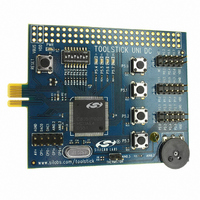TOOLSTICKUNIDC Silicon Laboratories Inc, TOOLSTICKUNIDC Datasheet - Page 2

TOOLSTICKUNIDC
Manufacturer Part Number
TOOLSTICKUNIDC
Description
CARD DAUGHTER UNIVRSTY TOOLSTICK
Manufacturer
Silicon Laboratories Inc
Series
ToolStickr
Datasheet
1.TOOLSTICKUNIDC.pdf
(16 pages)
Specifications of TOOLSTICKUNIDC
Accessory Type
Daughter Card
Interface Type
USB
Operating Supply Voltage
2.7 V to 3.6 V
Lead Free Status / RoHS Status
Contains lead / RoHS non-compliant
For Use With/related Products
*
For Use With
336-1345 - TOOLSTICK BASE ADAPTER336-1182 - ADAPTER USB DEBUG FOR C8051FXXX
Lead Free Status / Rohs Status
Lead free / RoHS Compliant
Other names
336-1434
To o l St i c k U n i D C
2. Contents
The ToolStickUniDC kit contains the following items:
The ToolStickUniSK Starter Kit includes the following items:
A ToolStick daughter card requires a ToolStick Base Adapter to communicate with the PC. If the daughter card was
not purchased as part of a Starter Kit, ToolStick Base Adapters can be purchased separately at
www.silabs.com/toolstick.
3. ToolStick Overview
The purpose of the ToolStick is to provide a development and demonstration platform for Silicon Laboratories
microcontrollers and to demonstrate the Silicon Laboratories software tools, including the Integrated Development
Environment (IDE).
The ToolStick development platform consists of two components: the ToolStick Base Adapter and a daughter card.
The ToolStick Base Adapter provides a USB debug interface and data communications path between a Windows
PC and a target microcontroller.
The target microcontroller and application circuitry are located on the daughter card. Some daughter cards, such
as the ToolStick University Daughter Card, are used as general-purpose development platforms for the target
microcontrollers, and some are used to demonstrate a specific feature or application.
The ToolStick University Daughter Card features a Silicon Laboratories C8051F020 Mixed-Signal MCU. The
external circuitry on the daughter card includes a 22.1184 MHz crystal to enable UART communication, 4 LEDs, 4
push-button switches, an 8-bit DIP switch, a potentiometer, and a reset switch. Ports P0, P1, and P2 of the MCU
are accessible via standard headers. A separate header is available for analog input/output that connects external
signals to the ADC and comparator inputs, and DAC outputs of the MCU. A small area for prototyping is also
provided that can be used to connect additional hardware to the microcontroller and use the daughter card as a
development platform.
Figure 3 shows the ToolStick University Daughter Card and identifies the various components.
2
ToolStick University Daughter Card
ToolStick Base Adapter
ToolStick University Daughter Card
3-foot USB extension cable
Rev. 0.1

























